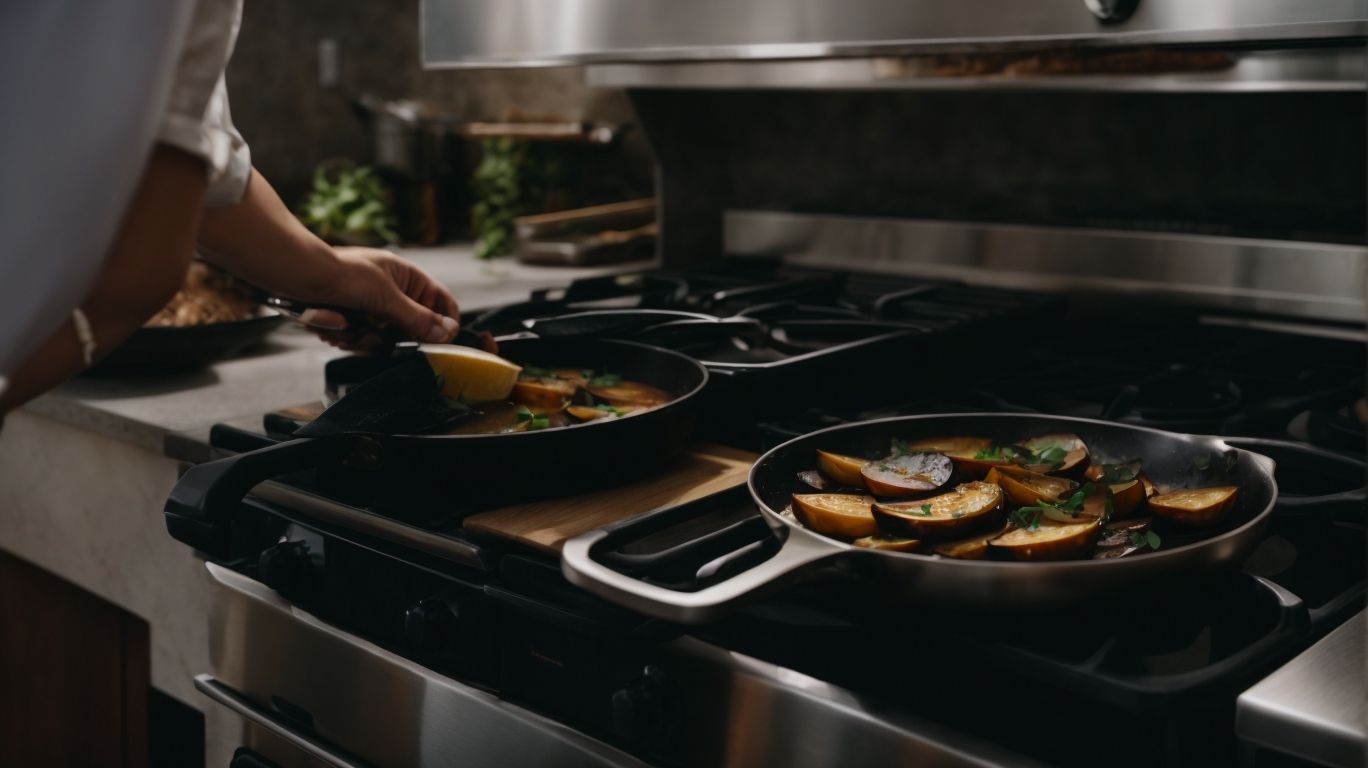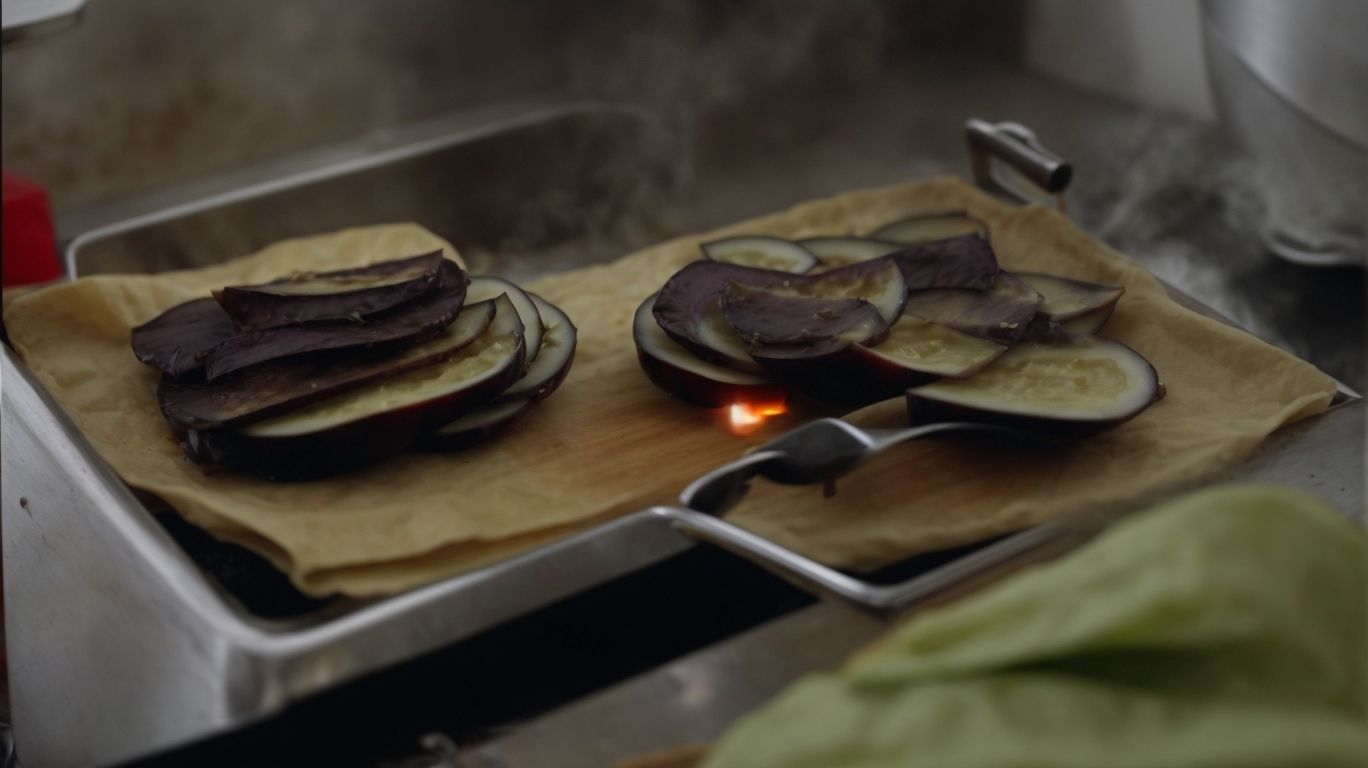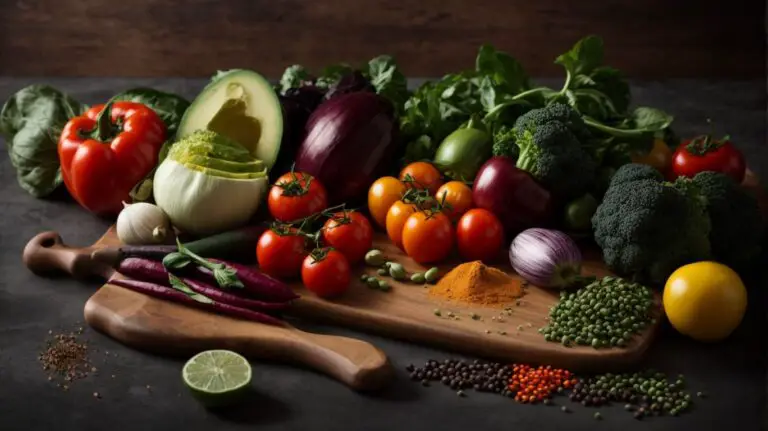How to Cook Eggplant on Stove?
Eggplant, also known as aubergine, is a versatile vegetable that can be cooked in a variety of ways.
This article explores the benefits of cooking eggplant on the stove and provides tips and recipes for delicious dishes.
From choosing the right eggplant to preparing and cooking it on the stove, we guide you through every step.
If you want to learn how to cook eggplant on the stove and enjoy its health benefits, keep reading!
Key Takeaways:
Why Should You Cook Eggplant on Stove?
Cooking eggplant on the stove offers a versatile and flavorful way to prepare this ingredient for a variety of dishes.
When cooking eggplant on the stove, you can enhance its natural flavors through methods such as sautéing, grilling, or pan-frying. These methods allow the eggplant to caramelize, bringing out its sweetness and adding a delightful charred aroma. Stove cooking offers the flexibility to easily incorporate various spices, herbs, and seasonings to customize the taste profile of the eggplant dish.
The simplicity of stove cooking also makes it a convenient choice for preparing eggplant. Whether you are making a quick stir-fry, a rich curry, or a simple side dish, the stove provides precise heat control, enabling you to achieve the desired level of tenderness and flavor infusion in the eggplant.
Preparing the Eggplant
Preparing eggplant involves slicing it into desired shapes, soaking in salted water to reduce bitterness, and gathering other necessary ingredients for the recipe.
When slicing the eggplant, it is essential to choose a sharp knife to ensure smooth and even cuts. The thickness of the slices can vary depending on the recipe; for grilling, thicker slices work best, while thinner slices are ideal for dishes like eggplant parmesan.
After slicing, sprinkle salt on both sides of the eggplant slices and let them sit for about 30 minutes. This process helps draw out excess moisture and bitterness from the eggplant. Rinse the salt off and pat dry before using.
To enhance the flavor, consider seasoning the eggplant slices with olive oil, garlic, herbs, or spices before cooking. Pairing eggplant with tomatoes, basil, mozzarella, or Parmesan cheese can create a delicious and satisfying dish.
How to Choose the Right Eggplant?
Selecting the right eggplant for your recipe is crucial to ensure optimal taste and texture in the final dish.
When choosing an eggplant, look for one that has a shiny and smooth skin, free from any blemishes or soft spots, which indicates freshness and quality.
Firmness is another important factor to consider; the eggplant should feel heavy for its size and yield slightly to gentle pressure without being too soft. Opt for medium-sized eggplants as they tend to have a good balance of flavor and fewer seeds. Smaller eggplants can be more tender, while larger ones might have a more bitter taste.
How to Clean and Cut Eggplant?
Cleaning and cutting eggplant involves rinsing it thoroughly, removing the stem, and slicing it according to the recipe requirements.
After rinsing the eggplant, it’s important to first remove the stem end. This can be done by gently twisting off the green crown where the stem meets the vegetable, ensuring a clean cut and fresh appearance. Next, depending on the recipe, the eggplant can be sliced lengthwise or into rounds. If slicing lengthwise, make sure to maintain a consistent thickness for even cooking. When cutting into rounds, aim for uniform pieces to ensure they cook evenly.
Cooking Eggplant on Stove

Credits: Poormet.Com – Joseph Clark
Cooking eggplant on the stove is a simple yet rewarding process that involves heating a pan and sautéing the slices until tender and flavorful.
This method allows for the eggplant to cook and soften while developing rich flavors through the process of caramelization. When cooking eggplant, it’s essential to properly season the slices with salt before sautéing, as this helps draw out excess moisture and enhances the taste. Ensure that the pan is preheated over medium-high heat to achieve a nice sear on the eggplant, giving it a lovely charred exterior and a creamy interior.
Step-by-Step Guide to Cooking Eggplant on Stove
To cook eggplant on the stove, start by heating a pan with oil, adding seasoned slices, and sautéing until they are cooked through and beautifully browned.
Once the pan is adequately heated and the oil is shimmering, carefully place the eggplant slices into the pan, ensuring they are not overcrowded to allow even cooking. Season the slices with salt, pepper, and any other desired spices to enhance their flavor profile. As the eggplant cooks, you may notice it beginning to soften and develop a golden hue on the edges.
Remember to flip the slices occasionally to ensure that both sides are evenly cooked. The sautéing process typically takes around 8-10 minutes, depending on the thickness of the slices and the heat intensity. You can test the doneness by piercing the eggplant with a fork; it should be tender yet not mushy.
Tips for Perfectly Cooked Eggplant
To ensure perfectly cooked eggplant, remember to sauté over medium heat, allow for browning, use a lid for steaming, and monitor the cooking progress closely.
When sautéing eggplant, make sure to evenly coat the bottom of the pan with oil to prevent sticking and enhance the flavor. Consistently stirring the eggplant during the sautéing process helps in achieving a uniform texture and thorough cooking. For optimal browning, avoid overcrowding the pan and let the eggplant pieces breathe to get that caramelized exterior.
Recipes for Cooking Eggplant on Stove
There are numerous delightful recipes for cooking eggplant on the stove, ranging from Asian-inspired dishes to innovative methods of serving this versatile ingredient.
One popular method is to prepare a flavorful Asian stir-fry with eggplant, combining it with soy sauce, ginger, and garlic for a mouthwatering dish.
Alternatively, try a Mediterranean twist by grilling eggplant slices and layering them with tomatoes, mozzarella, and basil for a refreshing Caprese salad.
For a unique approach, consider making eggplant parmesan rounds by breading and frying the slices before adding marinara sauce and cheese, creating a delectable appetizer or main course.
Eggplant Parmesan
Eggplant Parmesan is a classic dish featuring crispy, browned eggplant slices layered with rich tomato sauce and melted cheese, creating a satisfying and indulgent meal.
To achieve that perfect crispy texture in Eggplant Parmesan, it’s crucial to properly prepare the eggplant slices. Begin by slicing the eggplant thinly, about 1/4 inch thick. Sprinkle them with salt and let them sit for about 30 minutes to draw out excess moisture. This step helps in preventing the eggplant from becoming soggy during cooking.
After the salting process, rinse the eggplant slices to remove the salt and moisture. Pat them dry with a paper towel to ensure they are ready for browning. The browning process adds depth of flavor and a satisfying crunch to the dish. Heat olive oil in a skillet over medium-high heat and brown the eggplant slices in batches until they are golden on both sides.
Once the eggplant slices are perfectly browned, it’s time to start layering your Eggplant Parmesan. Begin by spreading a layer of tomato sauce at the bottom of a baking dish. Place a single layer of the browned eggplant slices on top of the sauce. Continue layering with more sauce, eggplant, and shredded cheese, such as mozzarella and Parmesan, until you reach the top of the dish.
Top the final layer of eggplant with a generous amount of cheese to create that irresistible gooey topping when baked. Bake the assembled dish in the oven until the cheese is melted and bubbly, and the flavors have melded together beautifully.
Grilled Eggplant
Grilled eggplant offers a smoky flavor and tender texture, enhanced by a drizzle of olive oil and a sprinkle of aromatic seasoning for a delightful culinary experience.
When preparing grilled eggplant, it’s crucial to slice the eggplant into even pieces to ensure they cook uniformly. The grilling process involves preheating the grill to medium-high heat and brushing the eggplant slices lightly with olive oil to prevent sticking. Seasoning choices such as garlic powder, paprika, and oregano can add depth of flavor to the dish. Once on the grill, allow the eggplant to cook until tender, flipping halfway through for even charring. To elevate the dish further, consider topping the grilled eggplant with a balsamic glaze or a sprinkle of feta cheese, offering a burst of flavors that complement the smoky notes.
Eggplant Stir Fry
Eggplant stir-fry is a quick and flavorful dish that combines tender eggplant slices with vibrant Asian seasonings, creating a harmonious blend of textures and flavors.
When preparing Eggplant Stir Fry, it’s essential to master the art of stir-frying. The key is to cook over high heat, ensuring that the eggplant pieces remain tender yet slightly crisp on the outside. Asian seasonings like soy sauce, ginger, and garlic infuse the dish with depth and complexity. Proper heat management is crucial to achieving the desired caramelization without overcooking the vegetables. The textural contrasts of soft eggplant and crunchy veggies create a delightful mouthfeel that elevates the overall experience of this classic Asian-inspired dish.
Roasted Eggplant
Roasted eggplant presents a hearty and savory option, with thick slices baked to perfection in the oven, creating a robust and satisfying dish.
When preparing roasted eggplant, it’s crucial to cut the eggplant into uniform, thick slices to ensure even cooking. The thickness of the slices impacts both the texture and cooking time, so aim for slices around 1/2 to 3/4 inch thick.
Once the eggplant is sliced, drizzle olive oil over each piece to help with caramelization and add a rich flavor. Season generously with kosher salt and freshly ground black pepper to enhance the earthy taste of the eggplant as it roasts in the oven.
Roasting time for eggplant typically ranges from 25 to 35 minutes at 400°F. Monitor the eggplant as it bakes, flipping the slices halfway through to ensure even browning and caramelization.
Health Benefits of Cooking Eggplant on Stove

Credits: Poormet.Com – Alan Brown
Cooking eggplant on the stove not only enhances its flavor but also provides numerous health benefits, including being rich in antioxidants, fiber content, and aiding in weight loss.
Antioxidants found in eggplants, such as nasunin, help protect cells from damage and reduce the risk of chronic diseases like heart disease and cancer. The high fiber content in eggplant promotes digestive health by preventing constipation and maintaining a healthy gut microbiota.
Eggplants are low in calories but high in nutrients, making them an excellent choice for weight management. They can help you feel full longer, which can prevent overeating and support weight loss goals.
Rich in Antioxidants
Eggplant is a rich source of antioxidants, particularly when consumed fresh and prepared using stove cooking methods, offering significant health-promoting benefits.
The high antioxidant content in eggplant is largely attributed to compounds like anthocyanins and nasunin. These antioxidants play a crucial role in neutralizing harmful free radicals in the body, reducing oxidative stress, and lowering the risk of chronic diseases. Consuming fresh eggplant ensures that these antioxidants are preserved and readily available for absorption.
When cooked on the stove, eggplant retains much of its antioxidant properties compared to other cooking methods like deep-frying. Stove cooking techniques such as roasting or sautéing help enhance the flavors and nutrient retention of eggplant dishes, making them not only delicious but also highly nutritious.
Lowers Cholesterol Levels
Regular consumption of stove-cooked eggplant has been linked to lowering cholesterol levels, especially when prepared with heart-healthy seasonings and methods.
Eggplant, as part of a balanced diet, can contribute significantly to managing cholesterol due to its high fiber content and antioxidant properties. When stove-cooking eggplant, it is vital to use minimal oil to avoid excess saturated fats.
Opt for seasonings like garlic, herbs, and lemon juice rather than salt or heavy sauces to enhance flavor without compromising on cholesterol management. Incorporating grilled or baked eggplant dishes into your meal rotation can further support a heart-healthy diet.
Good Source of Fiber
Eggplant is a good source of dietary fiber, essential for digestive health, and the stove cooking method helps retain this valuable nutrient for optimal wellness.
Consuming foods rich in fiber, like eggplant, can aid in maintaining a healthy digestive system by promoting regular bowel movements and supporting gut health.
When preparing eggplant, opting for stove cooking methods such as sautéing or grilling helps preserve its fiber content more effectively than frying or deep-frying.
This is crucial as fiber aids in digestion and can reduce the risk of various digestive issues such as constipation.
Helps with Weight Loss
Including stove-cooked eggplant in a balanced diet can aid in weight loss goals, as this low-calorie and nutrient-rich vegetable offers a healthy and satisfying serving option.
One of the key reasons why eggplant is beneficial for weight loss is its impressive nutrient composition. Eggplants are packed with fiber, which can help in keeping you full for longer periods while aiding in digestion. They are a great source of vitamins and minerals that are essential for overall health. Due to its low-calorie nature, eggplant can be a smart choice for those looking to manage their weight without sacrificing taste or nutrition.
Conclusion
Cooking eggplant on the stove is a delightful culinary experience that not only elevates the flavor of this versatile ingredient but also offers a range of health benefits through various recipes and serving methods.
When you choose to cook eggplant on the stove, you unlock its potential to absorb flavors and develop a rich, creamy texture that is a true delight for your taste buds. This cooking method allows you to experiment with different seasonings, oils, and cooking techniques, resulting in endless variations of dishes that showcase the eggplant’s unique taste. Incorporating eggplant into your diet can provide essential nutrients, antioxidants, and dietary fiber that promote overall well-being.
Why You Should Try Cooking Eggplant on Stove?
Exploring the method of cooking eggplant on the stove opens up a world of culinary possibilities, allowing you to showcase the versatility of this ingredient and serve delightful dishes to family and friends.
When you cook eggplant on the stove, you can experiment with various flavor profiles by using different seasonings, sauces, and cooking techniques. This method offers a chance to infuse rich, smoky flavors into the eggplant, creating a vibrant and satisfying dish that is sure to impress your guests. Whether you prefer a classic Mediterranean twist with olive oil, garlic, and fresh herbs, or a spicy Asian-inspired marinade, stove-cooked eggplant can cater to a wide range of tastes.
Frequently Asked Questions
How to Cook Eggplant on Stove?
1) How do I prep the eggplant for stovetop cooking?
Start by washing the eggplant and cutting off the stem. Then, slice it into 1/4 inch rounds or cubes, depending on your recipe.
How to Cook Eggplant on Stove?
2) What is the best type of pan to use for cooking eggplant on the stove?
A non-stick pan or a cast iron skillet are both great options for cooking eggplant on the stove. Make sure the pan is well-seasoned to prevent sticking.
How to Cook Eggplant on Stove?
3) Do I need to peel the eggplant before cooking it on the stove?
It is not necessary to peel the eggplant before cooking it on the stove. The skin is edible and adds texture to your dish.
How to Cook Eggplant on Stove?
4) Can I cook the eggplant on high heat?
It is not recommended to cook eggplant on high heat as it can burn quickly. Medium heat is best for cooking eggplant on the stove.
How to Cook Eggplant on Stove?
5) How long does it take to cook eggplant on the stove?
Generally, it takes 10-15 minutes to cook eggplant on the stove. The cooking time may vary depending on the recipe and the size of the eggplant pieces.
How to Cook Eggplant on Stove?
6) Can I use oil other than olive oil for cooking eggplant on the stove?
Yes, you can use any type of cooking oil such as vegetable, canola, or avocado oil for cooking eggplant on the stove. Just make sure it has a high smoke point to prevent burning.




